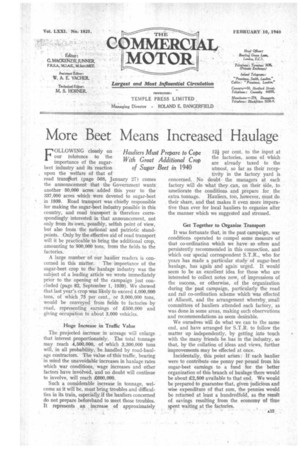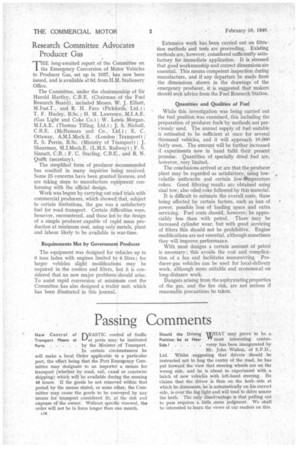More Beet Means Increased Haulage
Page 17

Page 18

If you've noticed an error in this article please click here to report it so we can fix it.
FOLLOWING closely on our reference to the importance of the sugarbeet industry and its reaction upon the welfare of that of road transport (page 568, January 27) comes the announcement that the Government wants another 50,000 acres added this year to the 337,000 acres which were devoted to sugar-beet in 1939. Road transport was chiefly responsible for making the sugar-beet industry possible in this country, and road transport is therefore correspondingly interested in that announcement, not only from its own, possibly, selfish point of view, but also from the national and patriotic standpoints. Only by the effective aid of road transport will it be practicable to bring the additional crop, amounting to 500,000 tons, from the fields to the factories.
A large number of our haulier readers is con cerned in this matter. The importance of the sugar-beet crop to the haulage industry was the subject of a leading article we wrote immediately prior to the opening of the campaign just concluded (page 82, September 1, 1939). We showed that last year's crop was likely to exceed 4,000,000 tons, of which 75 per cent., or 3,000,000 tons, would be conveyed from fields to factories by road, representing earnings of £500,000 and giving occupation to about 3,000 vehicles.
Huge Increase in Traffic Value The projected increase in acreage will enlarge that interest proportionately. The total tonnage may reach 4,500,000, of which 3,300,000 tons will, in all probability, be handled by road-haulage contractors. The value of this traffic, bearing in mind the unavoidable increases in haulage rates which war conditions, wage increases and other factors have involved, and no doubt will continue to involve, will reach £600,000.
Such a. considerable increase in tonnage, welcome as it will be, must bring troubles and difficulties in its train, especially. if the hauliers concerned do not prepare beforehand to meet those troubles. It represents an increase of approximately 12i per cent, to the input at the factories, some of which are already taxed to the utmost, so far as their receptivity in the factory yard is concerned. No doubt the managers at each factory will do what they can, on their side, to ameliorate the conditions and prepare for the extra tonnage. Hauliers, too, however, must do their share, and that makes it even more imperative than ever for local hauliers to organize after the manner which we suggested and stressed.
Get Together to Organize Transport It was fortunate that, in the past campaign, war conditions operated to compel some measure of that co-ordination which we have so often and persistently recommended in this connection, and which our special correspondent S.T.R., who for years has made a particular study of sugar-beet haulage, has again and again urged. It would seem to be an excellent idea for those who are interested to collect notes now, of impressions of the success, or otherwise, of the organization during the past campaign, particularly the road and rail co-ordination scheme which was effected at Allscott, and the arrangement whereby_ small committees of hauliers attended each factory, as was done in some areas, making such observations and recommendations as seem desirable.
We ourselves will do what we can to the same end, and have arranged for S.T.R. to follow the matter up independently, by getting into touch with the many friends he has in the industry, so that, by the collation of ideas and views, further improvements may be effected at once.
Incidentally, this point arises: If each haulier were to contribute one penny per pound from his sugar-beet earnings to a fund for the better organization of this branch of haulage there would be about £2,500 available to that end. We would be prepared to guarantee that, given judicious and wise expenditure of that sum, the pennies would be returned at least a hundredfold, as the result of savings resulting from the economy of time spent waiting at the factories.
Research Committee Advocates Producer Gas
THE long-awaited report of the Committee on • I the Emergency Conversion of Motor Vehicles to Producer Gas, set up in 1937, has now been issued, and is available at 9d. from H.M. Stationery Office.
The Committee, under the chairmanship of Sir Harold Hartley, C.B.E. (Chairman of the Fuel Research Board), included Messrs. W. J. Elliott, M.Inst.T., and R. H. Faro (Pick fords, Ltd.) ; T. F. Hurley, B.Sc. ; H. M. Lawrence, M.I.A.E.
(Gas Light and Coke Co.) ; W. Lewis Morgan, M.I.A.E. (Thomas Tilling, Ltd.) ; J. S. Nichol], C.B.E. (McNamara and Co., Ltd.) ; E. C.
Ottaway, A.M.I.Mech.E. (London Transport) ; E. S. Perrin, B.Sc. (Ministry of Transport); J. Shearman, M.I.Mech.E. (L.M.S. Railway) ; F. S. Sinnatt, C.B. ; F. C. Starling, C.B.E., and R. N. Quirk (secretary).
The simplified form of producer recommended has resulted in many inquiries being received.
Some 25 concerns have been granted licences, and are taking steps to manufacture equipment conforming with the official design.
Work was begun by carrying out road trials with commercial producers, which showed that, subject to certain limitations, the gas was a satisfactory fuel for road transport. Certain difficulties were, however, encountered, and these led to the design of a simple producer capable of rapid mass production at minimum cost, using only metals, plant and labour likely to be available in war-time.
Requirements Met by Government Producer The equipment was designed for vehicles up to 6 tons laden with engines limited to 4 litres ; for larger vehicles slight modifications may be required in the coolers and filters, but it is considered that no new major problems should arise. To assist rapid conversion at minimum cost the Committee has also designed a trailer unit, which has been illustrated in this journal. Extensive work has been carried out on filtration methods and tests are proceeding. Existing methods are, however, considered sufficiently satisfactory for immediate application. It is stressed that good workmanship and correct dimensions are essential. This means competent inspection during manufacture, and if any departure be made from the dimensions shown in the drawings of the emergency producer, it is suggested that makers should seek advice from the Fuel Research Station.
Quantities and Qualities of Fuel While this investigation was being carried out the fuel position.was examined, this including the preparation of producer fue'is by methods not previously used. The annual supply of fuel suitable is estimated to be sufficient at once for several thousand vehicles, and it will approach 10,000 fairly soon. The amount will be further increased if experiments now in hand fulfil their present promise. Quantities of specially dried fuel are, however, very limited.
The conclusions arrived at are that the producer plant may be regarded as satisfactory, using lowvolatile anthracite and certain low-ttomperature cokes. Good filtering result; are obtained using sisal tow, also oiled coke followed by this material.
It is difficult to estimate the overall costs, these being affected by certain factors, such as loss of power, possible loss of loading space and extra servicing. Fuel costs should, however, be appreciably less than with petrol. There may be increased cylinder wear, but with good servicing of filters this should not be prohibitive. Engine modifications are not essential, although sometimes they will improve performance.
With most designs a certain amount of petrol is necessary ; this avoids the cost and complication of a fan and facilitates manceuvring. Producer-gas vehicles can be used for local-delivery work, although more suitable and economical on long-distance work.
Dangers arising from the asphyxiating properties of the gas, and the fire risk, are not serious if reasonable precautions be taken.




























































